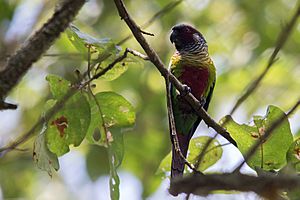Venezuelan parakeet facts for kids
Quick facts for kids Venezuelan parakeet |
|
|---|---|
 |
|
| Conservation status | |
| Scientific classification | |
| Genus: |
Pyrrhura
|
| Species: |
emma
|
| Synonyms | |
|
Pyrrhura picta emma |
|
The Venezuelan parakeet (also called Emma's conure) is a small, colorful bird. It belongs to the parrot family and lives only in Venezuela. Its scientific name is Pyrrhura emma.
Contents
About This Bird
Scientists sometimes have different ideas about how to group animals. The Venezuelan parakeet is a good example! Some experts, like the International Ornithological Committee (IOC), see it as its own special type of bird. Others think it's a subspecies, which is like a smaller group, of the painted parakeet. This article follows the idea that it is its own unique species.
What Does It Look Like?
The Venezuelan parakeet is about 22 to 23 centimeters (9 inches) long. Both male and female birds look the same.
- Head: They have a blue top of the head and a reddish-purple face. The back of their neck is gray-brown, and they have whitish feathers near their ears.
- Body: Most of their upper body is green. Their lower back is reddish-brown. Their chin and throat are gray-green with light, scale-like patterns. The middle of their belly is reddish-brown, and the rest of their underside is green.
- Wings and Tail: Their wings are mostly green, but they have a reddish-brown patch on their shoulder and blue main flight feathers. Their tail is reddish-brown.
- Other Features: Their beak is dark, and their eyes are orange to yellow. They have dark gray skin around their eyes that is not covered by feathers. Young birds look very much like the adults.
Where Does It Live?
The Venezuelan parakeet lives in two separate areas within the Venezuelan Coastal Range.
- One group lives between the states of Yaracuy and Miranda.
- Another group is found from Anzoátegui to Sucre and northern Monagas.
These parakeets like to live inside and at the edges of wet forests. They can also be found in open areas that have scattered trees. They usually live at elevations between 250 and 1,700 meters (820 to 5,580 feet) high. However, in Sucre, they can be found all the way down to sea level.
Behavior
Movement
Scientists do not know if the Venezuelan parakeet moves around a lot or stays in one place. It is not known to have any special migration patterns.
Feeding Habits
We do not know much about what the Venezuelan parakeet eats or how it finds food. They usually fly in groups of up to 30 birds. They have been seen eating fruits, flowers, and nectar.
Reproduction
The breeding season for the Venezuelan parakeet is thought to be from May to July. However, not much else is known about how they raise their young.
Sounds and Calls
The Venezuelan parakeet makes a loud, harsh call that sounds like "kik-kik-kik-kik." When they are upset or scared while sitting on a branch, they make a sound like "wa-Ke-Ke-Ke-ka."
Conservation Status
The IUCN (International Union for Conservation of Nature) has listed the Venezuelan parakeet as a species of "Least Concern." This means they are not currently in danger of disappearing.
Even though they have a large area where they live, their exact population size is unknown. It is believed that their numbers might be slowly going down. Some reasons for this decline could be:
- Trapping: Sometimes people catch these birds to sell them as pets.
- Habitat Changes: The places where they live are sometimes changed by human activities.
However, these threats are not considered very serious for this species right now. The Venezuelan parakeet is still fairly common. It also lives in several national parks and other protected areas, which helps keep them safe.
See also
 In Spanish: Perico pintado para niños
In Spanish: Perico pintado para niños


